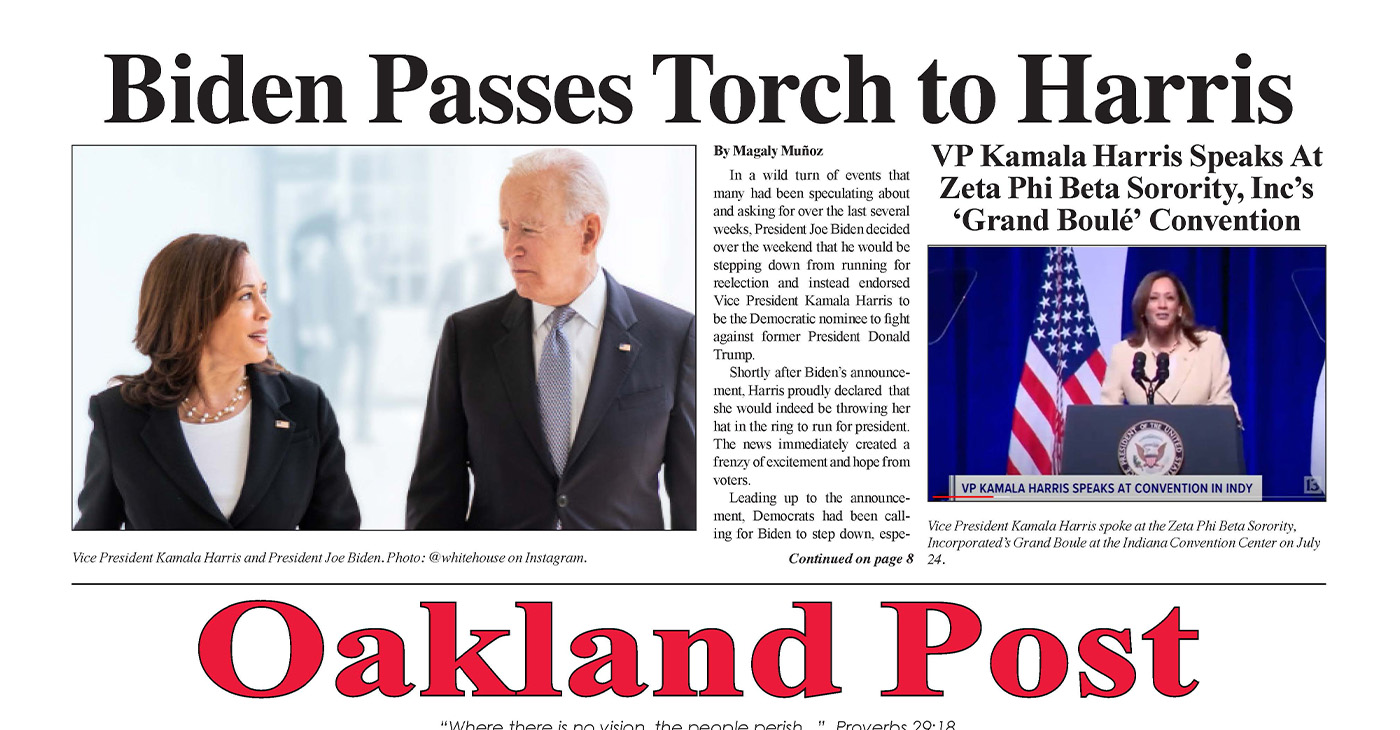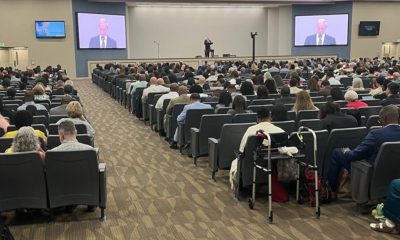City Government
Growing Voices Demand Coliseum City Must Yield Results for Residents
In the wake of the City Council decision to amend the Coliseum Area Specific Plan to protect businesses in the Oakland Airport Business Park, a coalition of local residents, Oakland workers, youth and faith leaders are stepping up efforts to make sure that the new development plan follows through on commitments to community benefits that include jobs and affordable housing for East Oakland residents.
The passage of the specific plan at the end of March means that zoning changes and environmental approvals are in place if the city can secure a deal to build a massive entertainment, retail, housing, and hotels complex that would be built around new sports arenas for the Oakland A’s and Raiders.
The specific plan, as passed, impacts 800 acres, including the current sports complex, parking lots, the area around the Coliseum BART station and the Oakland Airport Business Park, across the freeway from the Coliseum, which employs 8,000 workers and houses 150 businesses.
Though they want to see the project move ahead, members of the community benefits coalition want residents of East Oakland to enjoy the fruits of that development, not suffer the intense gentrification and environmental impacts that often go along with big development projects.
“The plan should protect current, longtime, deep-rooted residents of East Oakland,” said Rev. Damita Davis-Howard of Oakland Community Organizations (OCO), one of the groups in the coalition.
Seventy percent of Oaklanders are renters, Davis-Howard said. “With new development, there’s automatically a rise in costs. We don’t want current residents to be driven out because rents go up,” she said.
With the proposed project, over 5,000 residential units would be built around the new sports venues. Without a substantial amount of affordable housing units included in the project, current residents who make $30,000 or even $50,000 a year are likely to be priced out of the market.
“We need affordable housing, affordable grocery stores, and somewhere that we can go to just relax, like a nice family park,” said Theola Polk, a member of East Bay Housing Organizations (EBHO) who has lived in East Oakland for over 30 years.
“This area needs the same respect as the Coliseum City [project],” said Polk. “We want all of Oakland to look as good as Coliseum City is going to look; we want to get the same benefits.”
The transformation of Oakland neighborhoods has been long underway in other parts of the city – such as Uptown and West Oakland. However, new development often welcomes affluent renters and homeowners at the expense of longtime residents.

Jahmese Myres, Oakland resident and campaign director with the East Bay Alliance for a Sustainable Economy.
“There’s a lot at stake with this project because this is a really critical time in our city. Oakland is changing, and we want to see a project that really impacts Oakland in very positive ways,” said Jahmese Myres, campaign director with the East Bay Alliance for a Sustainable Economy (EBASE), which is part of the coalition.
“We have a choice to have a really corporate, cookie-cutter, formulaic development that has no relation to the surrounding community, or we can have a project that helps the community thrive with good jobs, affordable housing, cleaner air and allowing long-term residents to stay in the community,” Myres said, also a resident of East Oakland who lives within a mile of the proposed project.
Citing data that shows the median household income for East Oakland at $31,000 a year, Myres says housing in the project should “allow for folks making that income to be able to live in those units.”
The development could create up to 20,000 jobs and it is important that those jobs be real quality jobs that allow people to take care of their families, Myres added.
It’s important that “people working at the Coliseum now – ushers, ticket takers, etc. – that they keep their good union jobs, too. They’re also members of our community in a number of ways,” she said.
The city entered an Exclusive Negotiating Agreement (ENA) with a development team, which will present an outline of what the community benefits would include in June. The ENA expires in August but could be extended.
Organizations in the coalition include EBHO, OCO, EBASE, Communities for a Better Environment (CBE), Alliance of Californians for Community Empowerment (ACCE), Public Advocates, Unite Here 2850, Urban Peace Movement, SEIU-USWW – which represents workers at the Coliseum arena, Causa Justa/Just Cause, the Building Trades Council, Faith Alliance for a Moral Economy, and Partnership for Working Families.
Activism
Oakland Post: Week of July 24 – 30, 2024
The printed Weekly Edition of the Oakland Post: Week of July 24 – 30, 2024

To enlarge your view of this issue, use the slider, magnifying glass icon or full page icon in the lower right corner of the browser window. ![]()
Activism
Oakland Post: Week of July 17 -23, 2024
The printed Weekly Edition of the Oakland Post: Week of July 17 -23, 2024

To enlarge your view of this issue, use the slider, magnifying glass icon or full page icon in the lower right corner of the browser window. ![]()
Antonio Ray Harvey
Lawmakers Incensed by ‘Watering Down’ of Language in Child Sex Solicitation Bill
After an emotional hearing on July 2, the Assembly Public Safety Committee voted to advance Senate Bill (SB) 1414 with an 8-0 vote. The legislation is an anti-sex-trafficking measure designed to increase penalties for those who purchase sex from children, SB 1414, co- authored by Senators Shannon Grove (R-Bakersfield), Anna Caballero (D-Merced) and Senator Susan Rubio (D-Baldwin Park), will be reviewed by the Assembly Appropriations Committee after the Legislature break ends on Aug. 5.

By Antonio Ray Harvey
California Black Media
After an emotional hearing on July 2, the Assembly Public Safety Committee voted to advance Senate Bill (SB) 1414 with an 8-0 vote. The legislation is an anti-sex-trafficking measure designed to increase penalties for those who purchase sex from children,
SB 1414, co- authored by Senators Shannon Grove (R-Bakersfield), Anna Caballero (D-Merced) and Senator Susan Rubio (D-Baldwin Park), will be reviewed by the Assembly Appropriations Committee after the Legislature break ends on Aug. 5.
The legislation has received bipartisan support. However, “critical amendments” were removed, Grove said. She is not satisfied with the language currently in the bill and is pressing members of the Assembly Public Safety Committee to allow key provisions to be restored.
“I am disappointed that they didn’t accept the amendments for all minors to be protected under felony convictions,” Grove said after the committee’s vote.
“I am not going to give up fighting for those 16- and 17-year-olds – and all minors,” Grove stated. “Now, the district attorneys would have to prove two crimes: that they were bought and sold in order to go back to the perpetrator (trafficker) who initiated the whole process.”
SB 1414 made it off the Senate floor with a 36-0 bipartisan vote on May 23. Before the floor vote in the Senate, the Senate Public Safety Committee amended SB 1414, weakening protections for children ages 16 and 17, Grove said.
The committee’s amendments included charging violators who purchase children 15 and under for sex as ‘wobblers’ (crimes that can be punished as a felony or misdemeanor). According to the current language of the bill, solicitation of a 16- and 17-year-old child is only punishable as a misdemeanor. The second amendment to the bill calls for the felony charge to only carry possible jail time — not time in prison.
Grove and her supporters’ other concern is that a third amendment to SB 1414 states that only perpetrators with a previous conviction of buying sex from a child 15 or under, on the second offense and with over a 10-year age gap of the victim, must register as a Tier 1 sex offender.
Dr. Stephany Powell, a retired Los Angeles Police Department sergeant who has over 30 years of sexual exploitation and trafficking experience gained through law enforcement, testified in front of the Assembly Public Safety Committee.
“First of all, there’s no way in the world that (these amendments) are protecting a 16- or 17-year-old,” said Powell, who now assists victims of human trafficking. “Just by the age alone, they are considered to be a victim of human trafficking. That’s your proof right there.”
Assemblymember Kevin McCarty (D-Sacramento), chair of the Public Safety Committee and a member of the California Legislative Black Caucus (CLBC), told Grove that he supports SB 1414 and commended her efforts to bring “more accountability to the sex trade.”
McCarty said he is willing to make SB 1414 “stronger,” but he is not willing to allow Grove to buck the rules of the Legislature to push her amendments through.
“That’s not on the table. As the rules, you know, we can’t go change that,” McCarty said of Grove’s amendments request.
On June 2, Anne Irwin, the founder and director of Smart Justice California, emailed California Black Media (CBM) a statement responding to SB 1414. Smart Justice sides with the amendments made by the Democrats in the Senate and the Assembly.
“With the recently adopted amendments, SB 1414 now represents a smart policy solution that prioritizes the safety and well-being of all minors,” Irwin stated. “By allowing felony prosecutions for solicitation of 16- and 17-year-olds when there is evidence of human trafficking, lawmakers have further improved the bill – which was originally overly broad and would have had harmful unintended consequences.”
-

 Arts and Culture3 weeks ago
Arts and Culture3 weeks agoRooted in Tradition: The Intricate History of Black Hair Braiding
-

 Bay Area4 weeks ago
Bay Area4 weeks ago“I Will Not Be Bullied,” Says Oakland Mayor Sheng Thao
-

 Bay Area2 weeks ago
Bay Area2 weeks agoPG&E Increases Rates While Bay Area Households Are Struggling to Stay Afloat
-

 Business3 weeks ago
Business3 weeks agoGov Newsom: Raising Fast Food Minimum Wage to $20 Pays Off as Jobs Multiply in Industry
-

 Activism4 weeks ago
Activism4 weeks agoOpponents of Mayor Sheng Thao Are Calling on Her to Resign Following FBI Raid
-

 Community1 week ago
Community1 week agoHundreds Come to Jehovah’s Witnesses’ Assembly Hall for Three-Day Program of ‘Good News’ in Fremont
-

 Bay Area2 weeks ago
Bay Area2 weeks agoJuneteenth Mass Shooting Suspect Charge with Multiple Counts of Felony Assault by Alameda County DA Pamela Price
-

 Activism4 weeks ago
Activism4 weeks agoOakland Coliseum Sale to AASEG: A Model for Community Development and Inclusion
















































